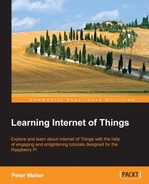Book Description
Explore and learn about Internet of Things with the help of engaging and enlightening tutorials designed for Raspberry Pi
In Detail
This book starts by exploring the popular HTTP, UPnP, CoAP, MQTT, and XMPP protocols. You will learn how protocols and patterns can put limitations on network topology and how they affect the direction of communication and the use of firewalls. Thing registries and delegation of trust are introduced as important tools to secure the life cycle of Things on the Internet. Once the fundamentals have been mastered, your focus will move to the Internet of Things architecture. A secure architecture is proposed that will take full advantage of the power of Internet of Things and at the same time protect end user integrity and private personal data without losing flexibility and interoperability.
This book provides you with a practical overview of the existing protocols, communication patterns, architectures, and security issues important to Internet of Things.
What You Will Learn
- Know the capabilities and limitations of the HTTP, UPnP, CoAP, MQTT, and XMPP protocols
- Use important communication patterns, such as the request/respond, publish/subscribe, event subscription, asynchronous messaging, and multicasting patterns
- Secure the life cycle of Things on the Internet by using Thing registries and delegation of trust
- Decrease complexity and development time by using Internet of Things service platforms
- Understand basic threats on the Internet and implement effective counter measures
- Combine interoperability and security to create open yet secure solutions
- Implement secure, scalable, decentralized, and interoperable architectures and solutions for Internet of Things
Downloading the example code for this book. You can download the example code files for all Packt books you have purchased from your account at http://www.PacktPub.com. If you purchased this book elsewhere, you can visit http://www.PacktPub.com/support and register to have the files e-mailed directly to you.
Table of Contents
- Learning Internet of Things
- Table of Contents
- Learning Internet of Things
- Credits
- About the Author
- About the Reviewers
- www.PacktPub.com
- Preface
- 1. Preparing our IoT Projects
- 2. The HTTP Protocol
- HTTP basics
- Adding HTTP support to the sensor
- Setting up an HTTP server on the sensor
- Setting up an HTTPS server on the sensor
- Adding a root menu
- Displaying measured information in an HTML page
- Generating graphics dynamically
- Creating sensor data resources
- Interpreting the readout request
- Testing our data export
- User authentication
- Adding events for enhanced network performance
- Adding HTTP support to the actuator
- Adding HTTP support to the controller
- Summary
- 3. The UPnP Protocol
- 4. The CoAP Protocol
- 5. The MQTT Protocol
- 6. The XMPP Protocol
- XMPP basics
- Adding XMPP support to a thing
- Providing an additional layer of security
- The basics of provisioning
- Initializing the Thing Registry interface
- Registering a thing
- Updating a public thing
- Claiming a thing
- Removing a thing from the registry
- Disowning a thing
- Initializing the provisioning server interface
- Handling friendship recommendations
- Handling requests to unfriend somebody
- Searching for a provisioning server
- Providing registry information
- Maintaining a connection
- Negotiating friendships
- Handling presence subscription requests
- Continuing interrupted negotiations
- Adding XMPP support to the sensor
- Adding a sensor server interface
- Updating event subscriptions
- Publishing contracts
- Adding XMPP support to the actuator
- Adding XMPP support to the camera
- Adding XMPP support to the controller
- Connecting it all together
- Summary
- 7. Using an IoT Service Platform
- Selecting an IoT platform
- The Clayster platform
- Interfacing our devices using XMPP
- Creating our control application
- Understanding rendering
- Defining the application class
- Initializing the controller
- Adding control rules
- Understanding application references
- Defining brieflets
- Displaying a gauge
- Displaying a binary signal
- Pushing updates to the client
- Completing the application
- Configuring the application
- Viewing the 10-foot interface application
- Summary
- 8. Creating Protocol Gateways
- 9. Security and Interoperability
- Index
